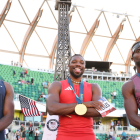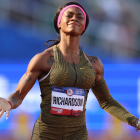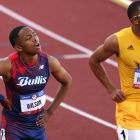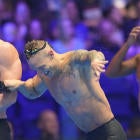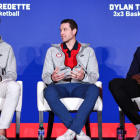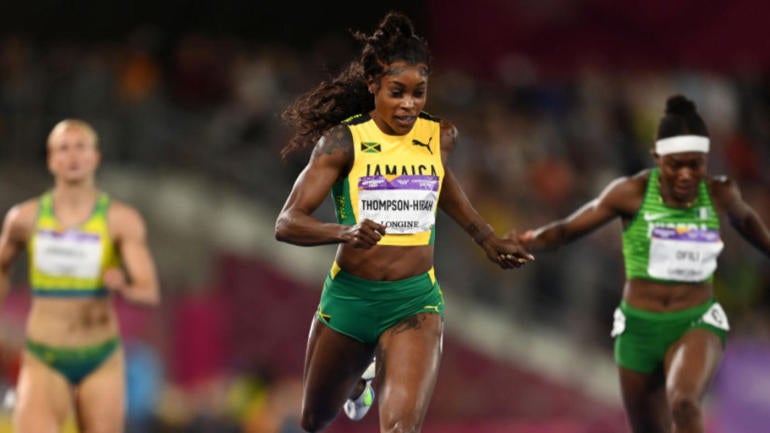
The 100 meters is one of the most popular events in the Olympics due to its simplicity and the excitement of seeing just how fast a human can run. As fans, we are thrilled at the prospect of seeing fractions of seconds getting shaved off sprinter's times as technology improves along with the advancements in the understanding of the mechanics of the human body, and this has been particularly true when it comes to women's events.
The women's 100-meter world record of 10.49 seconds set by Florence Griffith-Joyner has stood since 1988. For decades, that record has been considered practically impossible to beat, in part because of the controversy surrounding it, but with the gold-medal time having dropped in five straight Olympiads -- from 10.93 in 2004 to 10.61 in 2021 -- it now no longer seems far-fetched that the once unthinkable feat could fall.
With the U.S. Olympic Track & Field Trials getting underway Friday in Eugene, Oregon, and the Paris Games set to begin next month, it seems like the perfect time to dive deeper into the current women's 100-meter record and how far women have come in the sport as a whole.
Current 100m record and who could break it
The 10.49-world record set by the late Griffith-Joyner is considered to be controversial by some because of two reasons. First, there were concerns about the possible use of performance-enhancing substances, something that was not uncommon during the era, however, Griffith-Joyner never failed a drug test. The other issue cited had to do with questionable wind readings. In track, some performances are marked with "tailwind," a reference to when strong winds are at the competitor's backs. The legal limit is +2.0m/s, but when Griffith-Joyner set her record, the wind gauge indicated ±0.0m/s, this as the gauge at men's triple jump, an event that was happening at the same time, recorded a tailwind of +4.3m/s.
Before Griffith-Joyner's record, the best women's 100m time had been 10.76 by Evelyn Ashford in 1984. Among world-class athletes, a 0.27-second drop in a span of four years is essentially seen as obliteration of a record. (To put it another way, a 0.27-second drop from the current record would be a 10.22, a time that would've beaten Jesse Owens' 10.3 in the 1936 Berlin Games and one that would've secured a men's 100m gold as recently as the U.S.-boycotted 1980 Moscow Games.) But despite the 1988 controversy, the 10.49 time was ratified by the IAAF and the record still stands today. However, it no longer seems unbreakable.
Jamaica's Elaine Thompson-Herah set the second-fastest 100m time in women's running history at 10.54 during the Prefontaine Classic in 2021. She won the 100m event in the Tokyo Olympics, and she plans to defend her title in Paris, despite pulling out of the 200 meters after sustaining an apparent leg injury during a recent meet in New York.
"A few years ago, I was asked whether I could break that record and I said it was not possible," she told BBC in August 2021. "But for me to run a 10.54 means it is within reach, therefore it means anything is possible."
Another Jamaican sprinter, Shelly-Ann Fraser-Pryce, holds the third-best 100m time, and she is expected to compete in the Summer Games. She set a personal best of 10.60 in 2021, and the 37-year-old said Paris will be her fifth and final Olympics. Another runner to watch will be the current world champion American Sha'Carri Richardson, who expects to make her Olympic debut this summer. Her official personal best is 10.65, which she registered at Budapest last year.
Richardson is fresh of a 10.83-second 100m win at this year's Prefontaine Classic. Thompson-Herah finished ninth at 11.30, but she was thought to be just getting warmed up as she missed a significant amount of time last season due to injuries.
More opportunities, but so much more to do
The modern Olympic Games started in 1896, but women were not allowed to participate until 1928. The first IAAF-approved women's 100m was 13.6 seconds set by Marie Mejzlíková II on Aug. 5, 1922. Two weeks later, Britain's Mary Lines shattered it at 12.8 seconds.
It would be a similar story with regard to the most quintessential Olympic events -- the marathon. The debut of the women's marathon didn't come until the Los Angeles Games in 1984, nearly 90 years after the first men's Olympic marathon.
During the 2024 Boston Marathon, about 43% of finishers were female, which would not have been the case a little over 50 years ago. The first Boston Marathon was on April 19, 1897, but the first woman to run it with an official race number was Kathrine Switzer in 1967. This was not because women were not interested in marathons, but the Amateur Athletic Union had barred women from running long distances until 1972. Switzer's experience was less than ideal as she had other runners trying to stop her in the middle of the marathon.
"I knew if I quit, nobody would ever believe that women had the capability to run 26-plus miles. If I quit, everybody would say it was a publicity stunt. If I quit, it would set women's sports back, way back, instead of forward," Switzer said.
And as the opportunities have increased, so has the investment and research. The earliest running specific shoes have been around since at least the 1860s, however, it took another 110 years for the first female-specific shoe to hit the marketplace, when Nike launched the Lady Waffle Trainer in the 1970s. Now, athletic apparel companies are delving deeper than ever before into the physiological differences between the sexes.
One such example is Lululemon, a brand that started as women-focused first, but has since gotten into the men's footwear market. The company's spokespeople will tell you that there is a difference between shoes for women and shoes for men, and, for example, their Beyondfeel performance running shoe has seven differences between the versions. It would appear that there truth in the data as ultramarathon runner Camille Herron broke 13 different records -- including the women's six-day world record by running 560 miles -- during an event sponsored by the company. Still, the data exploring the needs of women in the athletic space lags behind what is needed, according to audits from leading sport and exercise journals.
But with or without the scientific data sets, the buzz around the mere possibility of seeing elite runners such as Richardson, Thompson-Herah and Fraser-Pryce attempt to eclipse a mark once thought to be unbreakable will have the eyes of the world glued to the track during this Olympic season.











